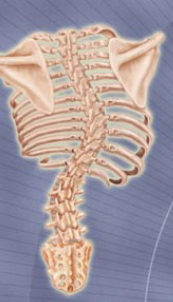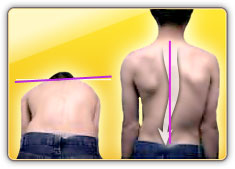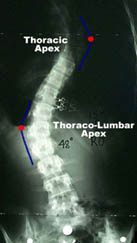Scoliosis is a condition in which the spine develops one or more abnormal, side-to-side curves that in turn may affect the body’s overall balance and alignment, as well as possibly lead to other physical and health problems. Although the condition may develop at any age, it most frequently appears during the early teen years of adolescence.
 What Is Adolescent Scoliosis?
What Is Adolescent Scoliosis?
A certain degree of curvature is normal in the human spine. For example, the gentle inward and outward curves of the neck, upper back and lower back are necessary for keeping the body properly balanced and aligned over the pelvis. When viewed from the back, the vertebrae of a healthy spine should form a straight line. In someone with scoliosis, however, the spine looks more like an “S” or a “C” than an “I”. The vertebrae involved in the curve also may rotate to some degree, which can further contribute to the appearance of an uneven waist or shoulders.
Scoliosis affects 2% of females and 0.5% of males in the general population. There are many causes of scoliosis, including congenital spine deformities, genetic conditions, neuromuscular problems and limb length inequality. Other causes for scoliosis include cerebral palsy, spina bifida, muscular dystrophy and tumors. More than 80% of scoliosis cases, however, are idiopathic, which means there is no known cause, and the person may otherwise be healthy. People with a family history of spinal deformity are at greater risk for developing scoliosis. Early detection is essential!
Idiopathic scoliosis may be broken down into four categories based on age:
- Infantile – children age 3 and under
- Juvenile – children age 3-9 years old
- Adolescent – children and young people age 10-18 years old
- Adult – following skeletal maturity
The most common form of scoliosis, representing approximately 80% of idiopathic scoliosis cases, is adolescent idiopathic scoliosis (AIS), which develops in young adults around the onset of puberty.
How Is Adolescent Scoliosis Diagnosed?
 For many adolescent patients, scoliosis is not painful; however, if left untreated, spinal curvature may become so severe that it does cause back pain and pain in other areas of the body, visible spinal deformity and other physical and health problems.
For many adolescent patients, scoliosis is not painful; however, if left untreated, spinal curvature may become so severe that it does cause back pain and pain in other areas of the body, visible spinal deformity and other physical and health problems.
In some young people with scoliosis, the spinal curvature is so slight it’s not visibly apparent during normal, everyday activities. Outward signs of scoliosis can, however, include:
- Shoulders are different heights – one shoulder blade is more prominent than the other
- Head is not centered directly above the pelvis
- Appearance of a raised, prominent hip
- Rib cages are at different heights
- Uneven waist
- Changes in look or texture of skin overlying the spine (dimples, hairy patches, color changes)
- Leaning of entire body to one side
Should you notice any one or more of these signs, you should schedule an exam with a provider.
A standard exam that is often used by pediatricians and in school screenings is called the Adam’s Forward Bend Test. Most schools test children in the fifth or sixth grade, and the Adam’s Forward Bend Test can be administered easily by school nurses or parent volunteers. For this test, the patient is asked to lean forward with his or her feet together and bend 90 degrees at the waist. The examiner can then easily view from this angle any asymmetry of the trunk or any abnormal spinal curvatures. It should be noted that this is a simple screening test that can detect potential problems, but cannot determine accurately the exact severity of the deformity.
If scoliosis is suspected, the diagnosis can be confirmed using diagnostic tools such as X-rays, computed tomography (CT) and magnetic resonance imaging (MRI). To determine the extent to which a curve has progressed, it’s measured using the Cobb Method and categorized in terms of degrees. Generally speaking, a curve is considered significant if it is greater than 25 to 30 degrees. Curves exceeding 45 to 50 degrees are considered severe and often require more aggressive treatment.
How Is Adolescent Scoliosis Treated?
 Treatment of adolescent scoliosis depends on the severity and location of the curve and its potential for progression, along with other factors such as the patient’s age and overall general health.
Treatment of adolescent scoliosis depends on the severity and location of the curve and its potential for progression, along with other factors such as the patient’s age and overall general health.
There are three basic treatment strategies for adolescent scoliosis:
- Observation
- Bracing
- Surgery
Observation or non-surgical treatment, such as bracing, are typically recommended as the first line of defense, and many scoliosis curves never progress to the point where surgery is necessary.
There are a variety of braces that are available for treating scoliosis; your provider will prescribe the one that’s right for you based on the type, location and degree of your curve. They include the:
- Boston Brace (Thoraco-Lumbo-Sacral-Orthosis “TLSO”) – the most commonly prescribed brace, also called a “low-profile” or “underarm” brace. It typically extends from below the breast to the beginning of the pelvic area in the front and from below the shoulder blades to the tail bone in the back
- Milwaukee Brace (Cervico-Thoraco-Lumbo-Sacral-Orthosis) – often used for high thoracic (mid-back) curves. It extends from the neck to the pelvis and consists of a specially contoured plastic pelvic girdle and a neck ring connected by metal bars in the front and the back of the brace.
- Charleston Bending Brace – worn only at night, the Charleston Bending Brace is molded to conform to the patient’s body while he or she is bent towards the convexity – or outward bulge – of the curve, the concept behind this design being that it “over-corrects” the curve during the eight hours the brace is worn.
- Providence Brace, a computer-fitted brace worn only at night.
- Wilmington Brace, a total-contact orthosis typically fabricated from a lightweight plastic material and designed as a “body jacket,” with a front closure and adjustable Velcro straps.

Boston Brace

